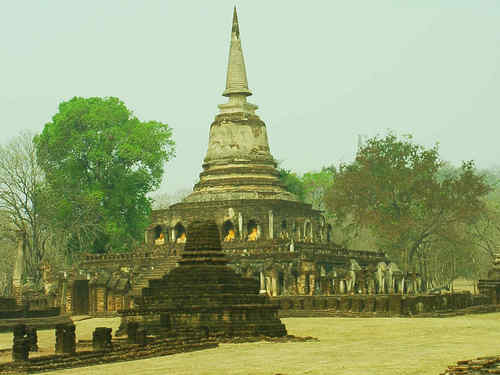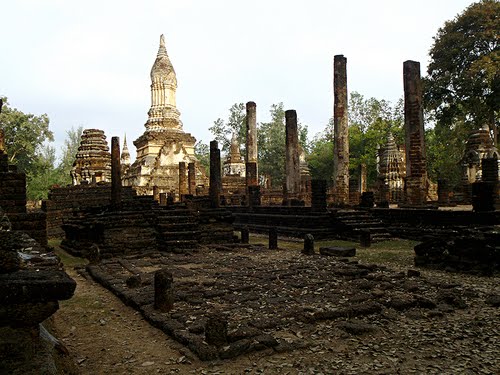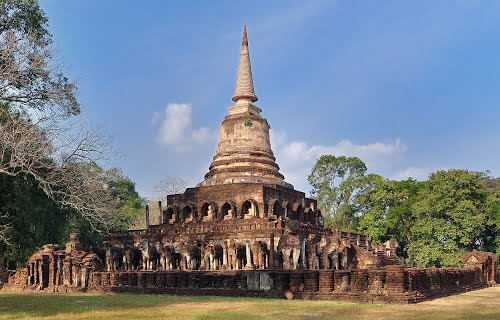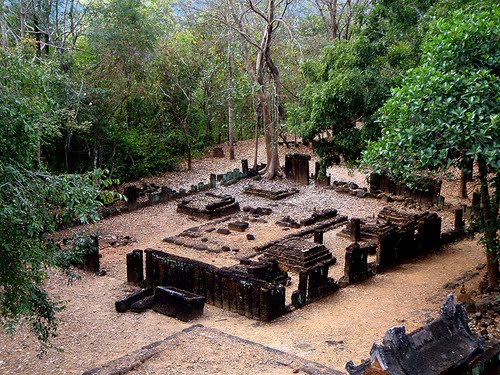The Si Satchanalai Historical Park is a historical park in Si Satchanalai district, Sukhothai Province, northern Thailand. The park covers the ruins of Si Satchanalai and Chaliang. Si Satchanalai, which literally means "City of good people", was founded in 1250 as the second center of Sukhothai Kingdom and a residence of the crown prince in the 13th and 14th centuries.
The city was rectangular in shape. In the 16th century, a 5-metre high wall with an upstream moat was built to fend off the growing Burmese attacks. The location of the town was facilitated by two the neighborhood dominant hill. The park is maintained by the Fine Arts Department of Thailand with help from UNESCO, which has declared it a World Heritage Site together with the associated historic parks in Kamphaengphet and Sukhothai.
History
Liberation from Khmer
Prior to the 13th century, Tai migrated into upper Chao Phraya valley and established a town named Chaliang, which means "City of Water" on the bank of Yom River. Chaliang gradually developed into an important trade center between China and Khmer Empire. The Chineses called the town as "Chengliang". The town enjoyed a substantial autonomy under Khmer until 1180, during the reign of Pho Khun Sri Naw Namthom who was the local ruler of Sukhothai and Sri Satchanalai, Khmer general Khomsabad Khlonlampong started to take control directly and introduced prohibitive taxes. In 1239 Pho Khun Bangklanghao and Pho Khun Pha Mueang decided to rebel and declare independence from Angkor and captured Chaliang. Chaliang was then became part of Sukhothai Kingdom.
Under Sukhothai
Under the reign of Sri Indraditya, in 1250 the new town area was built in the western area of Chalianf and named Si Satchanalai. Sri Indraditya send his sons, Ban Mueang, as a crown prince to govern the town. When Ban Mueang ruled the kingdom, he gave his brother Ramkhamhaeng control of the town of Si Satchanalai, and became a Sukhothai Kingdom's royal succession tradition to have a crown prince or heir of the throne ruled Si Satchanalai. The town had been granted the status of princely city or inner provincial city for its strategic location to the defense of kingdom capital in the northern direction, similar to Kamphaeng Phet in the west, Pitsanulok in the east, and Old Phichit in the south. There was a direct road from Sukhothai to Si Satchanalai called Phra Ruang Road. In 1345 Luethai wrote one of greatest works in Thai literature, Traibhumikatha or Traiphum Phra Ruang in Si Satchanalai.
The stele of Ram Khamhaeng states a stupa was erected in the center of Si Satchanalai, that took six years to build.
Lanna invasion and Ayutthaya domination
After the death of Ramkhamhaeng, Sukhothai Kingdom's dominance was reduced periodically, but unlike Sukhothai which suffered from urban decline, Si Satchanalai still abled to maintain its trading and industrial roles. In 1451 Tilokarat of Chiangmai annexed Si Satchanalai to his Lanna Kingdom and renamed the city to Chiangcheun. In 1474 Trailokkanat of Ayutthaya Kingdom started Ayutthaya-Lanna War and recaptured the city and renamed the city to Sawankhalok. During the reign of Ramathibodi II, the story of war campaigns between Tilokarat and Trailokkanat on Si Satchanalai inspired unknown poet to write Lilit Yuan Phai (Thai: ลิลิตยวนพ่าย), which is considered one of the best poetries of Ayutthaya Kingdom. Si Satchanalai became the thriving center of porcelain production for Ayutthayan court to export to oversea countries like Philippines, Japan and Indonesia. This prosperous period started in the 13th century and continued until the 16th century. The city reached its apex in economic and cultural development in the 14th century. In 1766 as part of Burmese–Siamese War (1765–67), the Burmese army from Lampang attacked Si Satchanalai and destroyed the city. After war, the city was rebuilt in the new area of present-day Sawankhalok thus the abandonment of the old city.
Later development
In 1907 Vajiravudh as a crown prince, made two months archaeological field trip to Nakhon Sawan, Kamphaeng Phet, Sukhothai, Si Satchanalai, Uttaradit and Pitsanulok. As part of this trip Vajiravudh found beautiful relics of Buddha image's head, a hand and feet in Si Satchanalai and brought back to Bangkok. In 1911 he rebuilt the Buddha image which finished in 1913. This 7.20 m high standing Buddha image was named Phra Ruang Rojanarit Sri Indraditya Dhammobhas Mahavajiravudh Pujaneeya Bophitr and installed in the front of Phra Pathommachedi in Nakhon Pathom.
Bhumibol and Sirikit, king and queen of Thailand, visited old Si Satchanalai, Chaliang and Sawankhalok in 1958. The protection of the area was first announced in Volume 92, Part 112 of the Royal Gazette on August 2, 1961. In 1976 the restoration project was approved, and in July 1988 the park was officially opened. On December 12, 1991, it was declared a World Heritage Site as part of the Historic Town of Sukhothai and Associated Historic Towns together with the associated historical parks in Kamphaeng Phet and Sukhothai.
During 2011 Thailand floods, flooding water from Yom River entered Si Satchanalai Historical Park inundating two historical pottery klins.



























